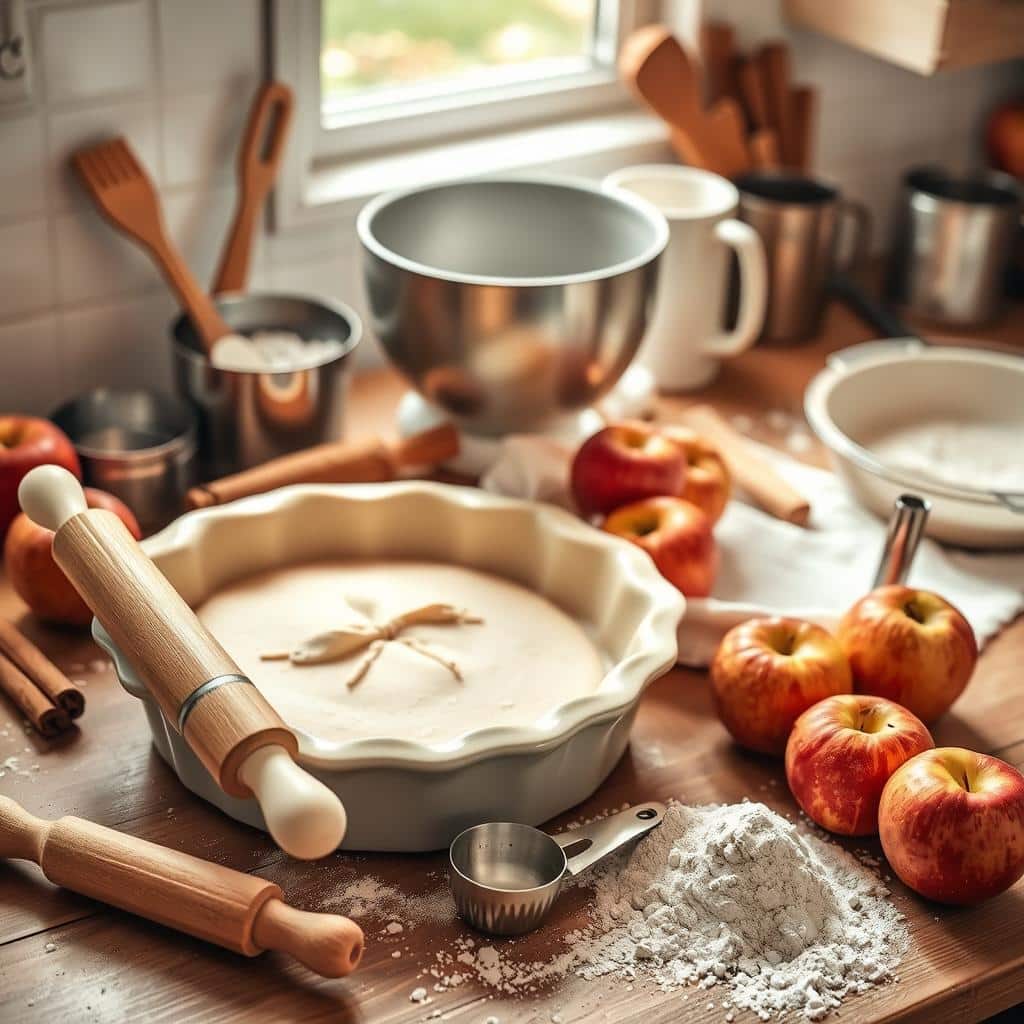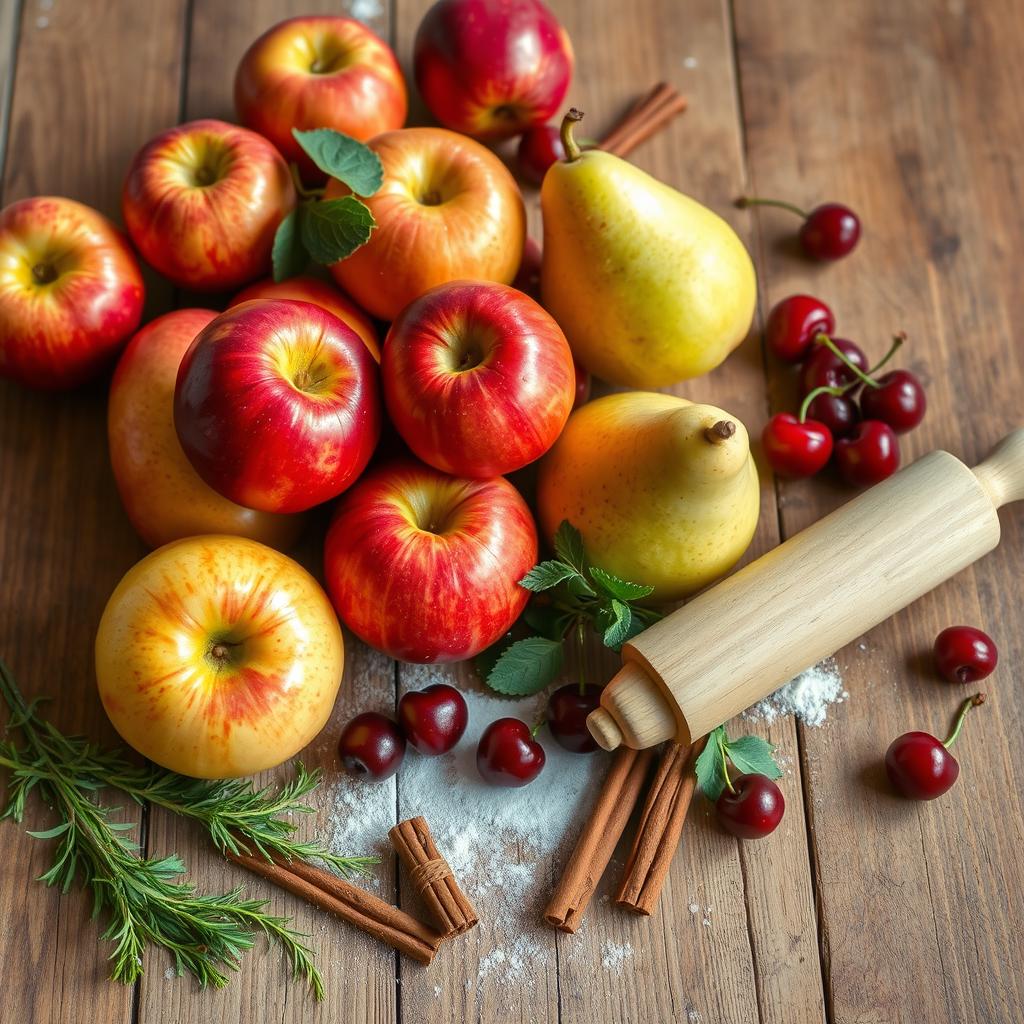As autumn arrives, the smell of apple pie in the kitchen brings back childhood memories. It’s a time to share delicious moments with family. Making this classic American dessert from scratch is truly special.
In this guide, you’ll learn to make the perfect homemade apple pie. We’ll cover everything from picking the right apples to making a flaky crust. You’ll gain the skills to impress your loved ones with this timeless treat. Get ready to enjoy the aroma of baking and share in this cherished tradition.
Key Takeaways
- Discover the history and cultural significance of classic American apple pie
- Learn how to select the best apples for a flavorful, balanced filling
- Understand the importance of using the right techniques to create a flaky, buttery crust
- Explore various methods for assembling and decorating your pie for a professional-looking result
- Uncover the secrets to achieving the perfect golden-brown crust every time
Understanding the Art of Traditional Apple Pie Making
Apple pie is a favorite dessert dish and a family tradition in America. It has a long history, starting with early settlers from Europe. They brought their apple pie recipes to the New World, where apples were plentiful.
As the country grew, so did the love for apple pie. It became a true comfort food.
Brief History of American Apple Pie
The first apple pie recipe in America was published in 1796. But, apple pie has roots in Europe, dating back to 1381. When English, Dutch, and other colonists came to America, they brought their pie recipes.
These recipes evolved into the classic American apple pie we all know and love.
Why Homemade Pies Taste Better
Homemade apple pies taste better than store-bought ones. Making a pie from scratch lets you use the freshest ingredients. You can choose the best apples and spices.
Also, making the dough by hand adds a special touch. It’s a labor of love that store-bought pies can’t replicate.
Essential Baking Equipment
- Rolling pin
- Pie dish or pan
- Mixing bowls
- Pastry blender or food processor
- Paring knife
- Apple peeler or corer
- Baking sheet
- Pie crust shield or foil
With the right tools and practice, you can make the perfect homemade apple pie. It will impress your family and friends.

Choosing the Perfect Apples for Your Pie
Choosing the right apples is key for the ultimate fruit pies. The right mix of seasonal ingredients can make your apple pie taste amazing. Let’s look at what makes the perfect apples for baking.
For a classic apple pie, mix tart and sweet apples. Here are some top picks:
- Granny Smith – These apples are tart and firm, perfect for holding their shape in the pie.
- Honeycrisp – They’re sweet and tangy, with a crisp bite that contrasts nicely with the pie filling.
- Gala – Gala apples are sweet and mild, balancing out the tartness of other apples.
- Braeburn – Braeburn apples are aromatic and firm, adding depth to your pie filling.
Choose apples that are firm, glossy, and free of blemishes. Avoid soft apples that might get mushy. Mix 3-4 varieties for a balanced flavor and texture in your pie.

After picking your apples, peel, core, and slice them evenly. This ensures they cook well and your pie looks great. With the right apples, you’re ready to make a pie that will impress everyone.
Creating the Perfect Flaky Pie Crust
Making a flaky, buttery pastry crust is key to a great apple pie. This section will show you how to make the perfect pie crust from scratch. You’ll learn about using cold butter versus shortening and the step-by-step dough handling techniques.
Cold Butter vs. Shortening Debate
The debate on cold butter versus shortening for flakiness is ongoing. Shortening makes the crust tender, but butter adds a rich flavor. The choice depends on your preference and the crust texture you want for your pastry crusts and baking recipes.
Step-by-Step Pastry Techniques
- Begin with chilled ingredients, including butter or shortening and water, to keep the dough cold and easy to work with.
- Use a food processor or your hands to mix the fat into the flour quickly. Be careful not to overwork the dough.
- Knead the dough gently, then split it into two parts. Shape them into discs and chill for at least 30 minutes.
- When it’s time to roll out, lightly flour your surface. Use a rolling pin to flatten the dough into a circle, about 1/8-inch thick.
Preventing Common Crust Problems
- Don’t overbake to avoid a tough, dry crust.
- Make sure the dough is well-chilled before rolling and baking to keep it flaky.
- Use a pie shield or foil to protect the edges from burning in the last stages of baking.
- Brush the crust with an egg wash for a golden, shiny finish.
By learning these techniques and solving common problems, you’ll make a flaky pie crust. This will take your homemade apple pies to the next level.
Apple Pie Filling Ingredients and Preparation
Making the perfect fruit pies begins with the filling. For apple pie, finding the right mix of sweet, tart, and spice is key. Learn the essential ingredients and steps to make a delicious apple pie filling that will impress everyone.
The Apple Conundrum
The choice of apples is crucial for your filling. Use a mix of seasonal ingredients like Honeycrisp, Granny Smith, and Gala apples. This mix gives the best flavor and texture.
- Honeycrisp apples add a nice crunch and sweetness.
- Granny Smith apples bring a tangy, tart flavor.
- Gala apples add a unique flavor that goes well with the others.
Spices and Sweeteners
After picking the right apples, think about the flavors that support them. Spices like cinnamon, nutmeg, and cloves are must-haves. A bit of brown sugar or maple syrup can also sweeten the fruit.
| Ingredient | Amount | Purpose |
|---|---|---|
| Ground cinnamon | 1 teaspoon | Warm, aromatic spice |
| Ground nutmeg | 1/4 teaspoon | Subtle, nutty flavor |
| Ground cloves | 1/8 teaspoon | Depth of flavor |
| Brown sugar | 1/2 cup | Sweetener and caramelization |
With the right apples and spices, you’re set to make a fruit pies filling that will delight your guests.
“The secret to a great apple pie is in the filling. Get that right, and the rest will fall into place.”
Mastering the Art of Pie Assembly
Making the perfect classic American cuisine apple pie is more than just the filling and crust. How you put the pie together affects its look and feel. Let’s dive into the art of pie assembly, from picking the right top crust to making decorative edges that wow your guests.
Lattice Top vs. Traditional Top Crust
When assembling your pie, you’ll decide between a lattice top or a solid top crust. The lattice top, with its woven dough, brings a rustic charm to your baking recipes. On the other hand, a solid top crust offers a classic and elegant look. Think about the look you want for your pie.
Decorative Edge Techniques
The edge of your pie crust is a chance to show off your baking skills. You can try simple crimping or more detailed designs. Try the fork-pressed edge, scalloped edge, or braided edge to match your style.
Egg Wash Applications
Using an egg wash on your pie crust can make a big difference. It gives the crust a golden color and helps keep the filling inside. Make sure to apply it evenly and lightly to avoid too much shine.
The art of pie assembly is about finding the right mix of looks and function. By mastering these techniques, you’ll make baking recipes that taste great and look amazing.
Baking Temperature and Timing Guidelines
Getting the right baking temperature and timing is key for making delicious baking recipes and dessert dishes. Whether you’re an experienced baker or new to the kitchen, knowing the best baking conditions for your apple pie is crucial. It can make a big difference in getting a perfect final product.
To get your homemade apple pie golden brown and flaky, preheat your oven correctly. The ideal temperature is between 375°F and 425°F, with 400°F being a good choice. This temperature helps the crust get a nice color and the filling cook evenly without burning.
The baking time for your apple pie depends on the pie dish size and oven type. A standard 9-inch pie usually bakes for 40 to 50 minutes. But, it’s important to watch your pie closely and adjust the time if needed. The crust should be golden, and the filling should be bubbly and thick.
If you’re using a convection oven, lower the temperature by 25°F and check the pie a bit earlier. For larger or deeper pies, you might need to bake them longer to ensure the center is cooked right.
Perfect baking comes from being attentive and making adjustments as you go. By watching your apple pie and using your senses, you’ll make a dessert dish that everyone will love.
| Oven Type | Temperature | Baking Time |
|---|---|---|
| Conventional Oven | 375°F – 425°F | 40 – 50 minutes |
| Convection Oven | 350°F – 400°F | 35 – 45 minutes |
| Deep Dish Pie | 375°F – 425°F | 50 – 60 minutes |
By following these baking recipes and timing tips, you’ll be on your way to making a kitchen masterpiece. Remember, baking is an art. With practice and attention to detail, you can make a perfect apple pie every time.
Tips for Achieving the Perfect Golden Brown Crust
Baking the perfect apple pie is an art. The secret to a beautifully golden-brown crust lies in mastering a few key techniques. As you embark on your baking recipes, pay close attention to the importance of steam vents and the effective use of pie shields.
Steam Vents and Their Importance
Creating strategic steam vents in your pastry crusts is essential for achieving that coveted golden-brown hue. These small openings allow excess steam to escape during baking. This prevents the crust from becoming soggy or underbaked.
By properly positioning and sizing your steam vents, you’ll ensure even heat distribution. This results in a perfectly crisp, flaky finish.
Using Pie Shields Effectively
Pie shields, often made of aluminum foil or specialized baking accessories, play a vital role. They protect your pastry crusts from over-browning. As the pie bakes, the edges tend to brown faster than the center.
By carefully placing a pie shield around the outer crust, you can control the browning process. This ensures an even, deep golden color throughout.
With these tips for managing steam vents and utilizing pie shields, you’ll be well on your way to baking the most delectable, visually stunning apple pies. Your family and friends will rave about your pastry crusts. Embrace the art of baking and let your creativity shine through each delicious slice.
Serving and Storage Recommendations
After baking your homemade apple pie to perfection, it’s time to enjoy it. Let it cool completely before slicing. This ensures the filling sets and the flavors develop fully.
Serve your pie slightly warm or at room temperature. A scoop of vanilla ice cream or a dollop of whipped cream adds a nice touch. It enhances the flavors and contrasts the textures.
Proper Storage for Maximum Freshness
To keep your homemade dessert dishes fresh, follow these storage tips:
- Allow the pie to cool completely before covering.
- Store the pie at room temperature for up to 2 days, covered with a clean kitchen towel or loosely wrapped in aluminum foil.
- For longer storage, refrigerate the pie for up to 4 days, covered with plastic wrap or in an airtight container.
- Freeze the pie for up to 3 months, tightly wrapped in plastic wrap and aluminum foil or placed in a freezer-safe bag.
When you’re ready to serve, thaw the frozen pie at room temperature for 4-6 hours or in the refrigerator overnight. Reheat slices in the oven or microwave before serving. This brings back the warm, comforting flavors of your homemade comfort foods.
“The perfect slice of apple pie is a moment of pure joy and indulgence.”
| Serving Recommendations | Storage Guidelines |
|---|---|
|
|
Conclusion
Making a homemade apple pie from scratch is a rewarding journey. It connects you to the rich tradition of classic American cuisine. By choosing the right apples, mastering the flaky crust, and perfecting the filling, you’ve made a dessert that pleases your taste buds and becomes a family tradition.
This time-honored recipe is a way to bring loved ones together. It’s a chance to share stories and celebrate life’s simple pleasures. Whether it’s for a special occasion or just a cozy treat, your homemade apple pie brings back memories of a bygone era. It reminds you of the timeless appeal of this beloved American classic.
Let this experience inspire you to try more apple pie recipes and techniques. Try different apple varieties, crust styles, and creative garnishes to make each pie your own. The true joy is in creating something with your own hands and sharing it with those you love.
FAQ
What are the best apple varieties for baking a classic apple pie?
For a great apple pie, mix tart and sweet apples. Try Granny Smith, Honeycrisp, or Braeburn. These apples stay firm and taste perfect together.
How can I make sure my pie crust turns out flaky and tender?
Use cold butter or shortening for a flaky crust. Handle the dough little to keep it tender. Chill the dough and roll it gently to avoid toughening.
Do I need to pre-bake the bottom crust before adding the filling?
You don’t always need to pre-bake the bottom crust for apple pie. But, it helps if your filling is very juicy. Use pie weights or beans to keep the crust flat.
How do I prevent the apples from becoming mushy in the pie?
Slice apples thinly and toss with sugar, spices, and a bit of cornstarch. This keeps them firm and prevents mushiness.
Should I cover the pie with a top crust or a lattice top?
Choose between a full top crust or a lattice top. A full crust looks traditional, while a lattice top is decorative. Pick what you like best.
How long should I bake the apple pie, and at what temperature?
Start at 425°F (220°C) for 15-20 minutes. Then, lower to 350°F (175°C) for 30-40 minutes. Watch it until the crust is golden and the filling bubbles.
Can I make the apple pie filling in advance?
Yes, make the filling ahead and refrigerate it. This saves time. Let it warm up before filling the crust.
How should I store leftover apple pie, and how long will it keep?
Keep leftover pie at room temperature for 2 days or in the fridge for 4. Cover it to keep the crust fresh. Reheat in the oven or microwave for a warm pie.

